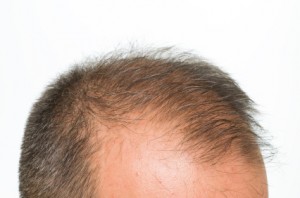No one looks forward to losing their hair; it impacts our appearance and typically makes us look older. Yet in the United States today, there are over 100 million men and women, combined, who suffer from one form of hair loss or another. While there are a myriad of solutions aimed at restoring the appearance of one’s own hair (non-surgical), relocating hair (surgical), or re-growing hair (medications and lasers), it may be helpful to get to the root of the problem and understand why hair loss happens in the first place.
Hair Loss: Typically in the Genes
Why doesn’t hair loss happen to all people for the same reason? Some people will experience hair loss due to a severely traumatic event. Some, though not all, will suffer hair loss if undergoing cancer treatment in the form of chemotherapy. In each of these instances, people can expect their hair to grow back in most cases. Some people suffer hair loss in patches, and these patches can actually move around to different areas of the scalp. Others don’t have any body hair at all, so theirs is less a case of hair loss and more a case of not having had a head of hair to begin with
While not all forms of hair loss are caused by the same thing, the vast majority of people experience hair loss as a result of a genetic pre-disposition. That means if you are suffering from hair loss, it’s probably in your genes.
Rate of Hair Loss the Same for Most People
When people start noticing their hair loss, there is often an assumption that they are losing hair at a faster rate than normal. They will see large clumps of hair in their comb or, perhaps, an increasing amount on their pillow. This is typically when the mirror comes out and various angles are viewed to confirm their suspicion that hair loss is occurring. The reality is that these people are not suffering from hair loss at any more of an accelerated rate than anyone else. It’s just that their hair isn’t growing back. You see, everyone’s hair has a cycle of growth. Not all of your hair is actively growing at the same time.
Hair Loss Through the Years
When a baby is first born, it is not uncommon to see the newborn with what appears to be a fairly full head of hair. Within the baby’s first weeks, however, they appear to suffer what may look like hair loss. In reality, those first hairs are simply breaking away. Within weeks, the appearance of baby fine, light-colored hairs begin to become darker and thicker. From the early years, up through childhood, and onto adolescence we experience the greatest amount of activity amongst our scalp hair follicles. Hair loss isn’t even on our radar at this point as more of our hair is active at this time than at any other period in our lives. Once puberty hits, the shifting change in hormone levels causes much of a young person’s very fine, almost colorless vellus hair – or peach fuzz – to become darker and thicker. When boys become young men and move into their early 20’s, hair follicles in the scalp actually begin to become less active as their genetic programming dictates. Even at this young age, hair loss can begin to become noticeable.
Women typically experience hair loss in a very different way that is often not visually evident until much later in life. When menopause occurs, shifting hormones can trigger hair loss as some hair follicles respond to the body’s signals by producing finer hairs which can often be mistaken for less hair, or actual hair loss.
Finally, in our older years, an increasing number of hairs spend a greater period of time in the resting phase with many hair follicles never returning to the active state. Hair loss is at its greatest at this point with remaining hair being thin and fine.







